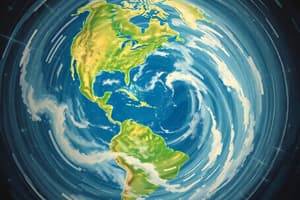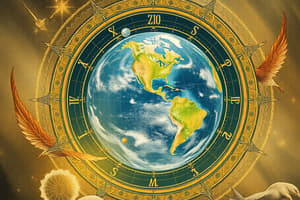Podcast
Questions and Answers
What are the two types of motion that the Earth undergoes?
What are the two types of motion that the Earth undergoes?
- Spinning and Revolution
- Displacement and Orbiting
- Rotation and Revolution (correct)
- Rotation and Translation
How long does it take for the Earth to complete one full rotation on its axis?
How long does it take for the Earth to complete one full rotation on its axis?
- 30 days
- 12 hours
- 365 days
- 24 hours (correct)
What causes day and night on Earth?
What causes day and night on Earth?
- The revolution of the Earth
- The changing of seasons
- The tilt of the Earth’s orbit
- The rotation of the Earth (correct)
What is the shape of Earth's orbit around the Sun?
What is the shape of Earth's orbit around the Sun?
How many days does the Earth take to complete one revolution around the Sun?
How many days does the Earth take to complete one revolution around the Sun?
What occurs every four years to account for the extra time taken by the Earth’s revolution?
What occurs every four years to account for the extra time taken by the Earth’s revolution?
What effect does the tilted axis of the Earth primarily have on the planet?
What effect does the tilted axis of the Earth primarily have on the planet?
Why do seasons differ between the Northern and Southern Hemispheres?
Why do seasons differ between the Northern and Southern Hemispheres?
What is the main reason that different parts of the Earth experience day and night at different times?
What is the main reason that different parts of the Earth experience day and night at different times?
Which phenomenon is a direct result of the Earth's revolution around the Sun?
Which phenomenon is a direct result of the Earth's revolution around the Sun?
How does the Earth’s axis contribute to the phenomenon of seasons?
How does the Earth’s axis contribute to the phenomenon of seasons?
The leap year adjustment is made to account for what aspect of Earth's revolution?
The leap year adjustment is made to account for what aspect of Earth's revolution?
Which statement correctly describes the nature of Earth's rotation?
Which statement correctly describes the nature of Earth's rotation?
What are the implications of the Earth's rotation being from west to east?
What are the implications of the Earth's rotation being from west to east?
In which scenario is the North Pole tilted towards the Sun?
In which scenario is the North Pole tilted towards the Sun?
What effect does the spherical shape of Earth have during rotation?
What effect does the spherical shape of Earth have during rotation?
The motion of the Earth on its axis is called ______.
The motion of the Earth on its axis is called ______.
The Earth takes about 365 days to complete one ______ around the Sun.
The Earth takes about 365 days to complete one ______ around the Sun.
Due to its motion from west to east, we see the sunrise in the ______.
Due to its motion from west to east, we see the sunrise in the ______.
The Earth's axis is always ______, which affects the seasons.
The Earth's axis is always ______, which affects the seasons.
There are four main seasons: spring, summer, ______, and winter.
There are four main seasons: spring, summer, ______, and winter.
Every fourth year, an extra day is added in February, making it a ______ year.
Every fourth year, an extra day is added in February, making it a ______ year.
The motion of the Earth revolving around the Sun occurs in a fixed path called an ______.
The motion of the Earth revolving around the Sun occurs in a fixed path called an ______.
The North Pole is tilted towards the Sun during ______.
The North Pole is tilted towards the Sun during ______.
The Earth takes about 24 hours to complete one revolution around the Sun.
The Earth takes about 24 hours to complete one revolution around the Sun.
The Earth's axis is tilted and always points in the same direction.
The Earth's axis is tilted and always points in the same direction.
During the summer in the Southern Hemisphere, the North Pole is tilted towards the Sun.
During the summer in the Southern Hemisphere, the North Pole is tilted towards the Sun.
Every four years, an extra day is added to account for the Earth's rotation.
Every four years, an extra day is added to account for the Earth's rotation.
The revolution of the Earth is responsible for creating day and night.
The revolution of the Earth is responsible for creating day and night.
The Earth's orbit around the Sun is circular in shape.
The Earth's orbit around the Sun is circular in shape.
The Northern Hemisphere experiences summer when the North Pole is tilted towards the Sun.
The Northern Hemisphere experiences summer when the North Pole is tilted towards the Sun.
Due to Earth's rotation, every location on Earth experiences sunrise and sunset simultaneously.
Due to Earth's rotation, every location on Earth experiences sunrise and sunset simultaneously.
Explain how the Earth's rotation affects the perception of time in different locations.
Explain how the Earth's rotation affects the perception of time in different locations.
What is the role of the Earth's tilted axis in the changing of seasons?
What is the role of the Earth's tilted axis in the changing of seasons?
Discuss the significance of a leap year in relation to Earth's revolution.
Discuss the significance of a leap year in relation to Earth's revolution.
How does the motion of revolution contribute to the occurrence of seasons?
How does the motion of revolution contribute to the occurrence of seasons?
Why do we experience longer days during summer in the Northern Hemisphere?
Why do we experience longer days during summer in the Northern Hemisphere?
What happens during winter in the Southern Hemisphere when the North Pole is tilted away from the Sun?
What happens during winter in the Southern Hemisphere when the North Pole is tilted away from the Sun?
Describe how the shape of the Earth's orbit affects its movement around the Sun.
Describe how the shape of the Earth's orbit affects its movement around the Sun.
What would happen if the Earth's axis were not tilted?
What would happen if the Earth's axis were not tilted?
Flashcards are hidden until you start studying
Study Notes
Earth's Motion
- Ancient belief: Earth is stationary; heavenly bodies move around it.
- Nicolaus Copernicus introduced the concept of Earth's motion in the 16th century.
- Earth has two types of motion: rotation and revolution.
Rotation
- Definition: The motion of the Earth on its axis, an imaginary line through its center.
- Axis endpoints: North Pole (top) and South Pole (bottom).
- The tilt of the axis: Always tilted in the same direction; not vertical.
- Duration: Takes about 24 hours to complete one rotation.
- Direction: Earth rotates from west to east.
- Sun's apparent movement: Sunrise in the east and sunset in the west.
Effects of Rotation
- Cause of day and night: Half of Earth faces the Sun (day) while the other half is in darkness (night).
- All locations experience day and night at different times.
Revolution
- Definition: Earth's movement around the Sun while rotating on its axis.
- Path: Earth revolves along a fixed, oval-shaped path called the orbit.
- Duration: Approximately 365 days (1 year) to complete one revolution; actually takes 365 1/4 days.
- Leap year: Every fourth year, an extra day added in February; total of 366 days.
Effects of Revolution
- Cause of seasons: Four distinct seasons - spring, summer, autumn, and winter.
- Seasonal differences: Northern Hemisphere's seasons differ from the Southern Hemisphere's due to the Earth's tilted axis.
- Sunlight distribution:
- When North Pole tilts towards the Sun: Northern Hemisphere experiences summer (longer days).
- When South Pole tilts towards the Sun: Southern Hemisphere experiences summer (longer days).
- Equinox: Sun's rays directly fall on the Equator, resulting in equal day and night lengths throughout the year.
Earth's Motion
- Ancient belief: Earth is stationary; heavenly bodies move around it.
- Nicolaus Copernicus introduced the concept of Earth's motion in the 16th century.
- Earth has two types of motion: rotation and revolution.
Rotation
- Definition: The motion of the Earth on its axis, an imaginary line through its center.
- Axis endpoints: North Pole (top) and South Pole (bottom).
- The tilt of the axis: Always tilted in the same direction; not vertical.
- Duration: Takes about 24 hours to complete one rotation.
- Direction: Earth rotates from west to east.
- Sun's apparent movement: Sunrise in the east and sunset in the west.
Effects of Rotation
- Cause of day and night: Half of Earth faces the Sun (day) while the other half is in darkness (night).
- All locations experience day and night at different times.
Revolution
- Definition: Earth's movement around the Sun while rotating on its axis.
- Path: Earth revolves along a fixed, oval-shaped path called the orbit.
- Duration: Approximately 365 days (1 year) to complete one revolution; actually takes 365 1/4 days.
- Leap year: Every fourth year, an extra day added in February; total of 366 days.
Effects of Revolution
- Cause of seasons: Four distinct seasons - spring, summer, autumn, and winter.
- Seasonal differences: Northern Hemisphere's seasons differ from the Southern Hemisphere's due to the Earth's tilted axis.
- Sunlight distribution:
- When North Pole tilts towards the Sun: Northern Hemisphere experiences summer (longer days).
- When South Pole tilts towards the Sun: Southern Hemisphere experiences summer (longer days).
- Equinox: Sun's rays directly fall on the Equator, resulting in equal day and night lengths throughout the year.
Earth's Motion
- Ancient belief: Earth is stationary; heavenly bodies move around it.
- Nicolaus Copernicus introduced the concept of Earth's motion in the 16th century.
- Earth has two types of motion: rotation and revolution.
Rotation
- Definition: The motion of the Earth on its axis, an imaginary line through its center.
- Axis endpoints: North Pole (top) and South Pole (bottom).
- The tilt of the axis: Always tilted in the same direction; not vertical.
- Duration: Takes about 24 hours to complete one rotation.
- Direction: Earth rotates from west to east.
- Sun's apparent movement: Sunrise in the east and sunset in the west.
Effects of Rotation
- Cause of day and night: Half of Earth faces the Sun (day) while the other half is in darkness (night).
- All locations experience day and night at different times.
Revolution
- Definition: Earth's movement around the Sun while rotating on its axis.
- Path: Earth revolves along a fixed, oval-shaped path called the orbit.
- Duration: Approximately 365 days (1 year) to complete one revolution; actually takes 365 1/4 days.
- Leap year: Every fourth year, an extra day added in February; total of 366 days.
Effects of Revolution
- Cause of seasons: Four distinct seasons - spring, summer, autumn, and winter.
- Seasonal differences: Northern Hemisphere's seasons differ from the Southern Hemisphere's due to the Earth's tilted axis.
- Sunlight distribution:
- When North Pole tilts towards the Sun: Northern Hemisphere experiences summer (longer days).
- When South Pole tilts towards the Sun: Southern Hemisphere experiences summer (longer days).
- Equinox: Sun's rays directly fall on the Equator, resulting in equal day and night lengths throughout the year.
Earth's Motion
- Ancient belief: Earth is stationary; heavenly bodies move around it.
- Nicolaus Copernicus introduced the concept of Earth's motion in the 16th century.
- Earth has two types of motion: rotation and revolution.
Rotation
- Definition: The motion of the Earth on its axis, an imaginary line through its center.
- Axis endpoints: North Pole (top) and South Pole (bottom).
- The tilt of the axis: Always tilted in the same direction; not vertical.
- Duration: Takes about 24 hours to complete one rotation.
- Direction: Earth rotates from west to east.
- Sun's apparent movement: Sunrise in the east and sunset in the west.
Effects of Rotation
- Cause of day and night: Half of Earth faces the Sun (day) while the other half is in darkness (night).
- All locations experience day and night at different times.
Revolution
- Definition: Earth's movement around the Sun while rotating on its axis.
- Path: Earth revolves along a fixed, oval-shaped path called the orbit.
- Duration: Approximately 365 days (1 year) to complete one revolution; actually takes 365 1/4 days.
- Leap year: Every fourth year, an extra day added in February; total of 366 days.
Effects of Revolution
- Cause of seasons: Four distinct seasons - spring, summer, autumn, and winter.
- Seasonal differences: Northern Hemisphere's seasons differ from the Southern Hemisphere's due to the Earth's tilted axis.
- Sunlight distribution:
- When North Pole tilts towards the Sun: Northern Hemisphere experiences summer (longer days).
- When South Pole tilts towards the Sun: Southern Hemisphere experiences summer (longer days).
- Equinox: Sun's rays directly fall on the Equator, resulting in equal day and night lengths throughout the year.
Earth's Motion
- Ancient belief: Earth is stationary; heavenly bodies move around it.
- Nicolaus Copernicus introduced the concept of Earth's motion in the 16th century.
- Earth has two types of motion: rotation and revolution.
Rotation
- Definition: The motion of the Earth on its axis, an imaginary line through its center.
- Axis endpoints: North Pole (top) and South Pole (bottom).
- The tilt of the axis: Always tilted in the same direction; not vertical.
- Duration: Takes about 24 hours to complete one rotation.
- Direction: Earth rotates from west to east.
- Sun's apparent movement: Sunrise in the east and sunset in the west.
Effects of Rotation
- Cause of day and night: Half of Earth faces the Sun (day) while the other half is in darkness (night).
- All locations experience day and night at different times.
Revolution
- Definition: Earth's movement around the Sun while rotating on its axis.
- Path: Earth revolves along a fixed, oval-shaped path called the orbit.
- Duration: Approximately 365 days (1 year) to complete one revolution; actually takes 365 1/4 days.
- Leap year: Every fourth year, an extra day added in February; total of 366 days.
Effects of Revolution
- Cause of seasons: Four distinct seasons - spring, summer, autumn, and winter.
- Seasonal differences: Northern Hemisphere's seasons differ from the Southern Hemisphere's due to the Earth's tilted axis.
- Sunlight distribution:
- When North Pole tilts towards the Sun: Northern Hemisphere experiences summer (longer days).
- When South Pole tilts towards the Sun: Southern Hemisphere experiences summer (longer days).
- Equinox: Sun's rays directly fall on the Equator, resulting in equal day and night lengths throughout the year.
Studying That Suits You
Use AI to generate personalized quizzes and flashcards to suit your learning preferences.




